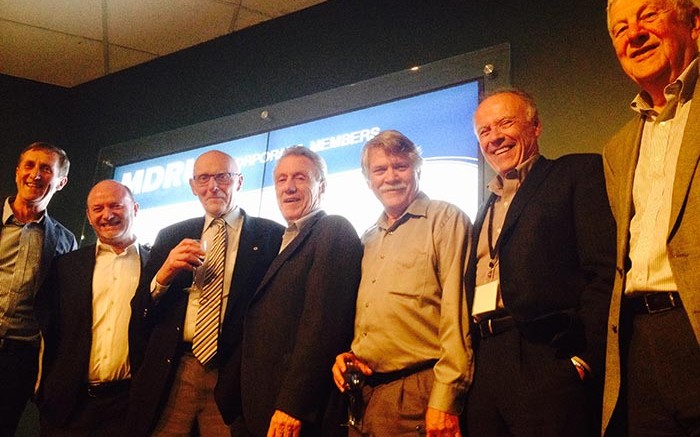VANCOUVER — The Mineral Deposit Research Unit (MDRU) at the University of British Columbia (UBC) held its 25th anniversary celebration in early April at the Vancouver Convention Centre, where Peter Bradshaw, cofounder and Canadian Mining Hall of Fame legend, shared his thoughts on the milestone.
“We wanted to create something that would allow the mining and exploration industry in Vancouver to strengthen its bond with UBC. And I have to say, the MDRU of today has exceeded my wildest expectations.”
Joining the audience was cofounder and first interim director John McDonald; the former dean of Earth and Ocean Sciences at UBC, Al Sinclair; current dean Paul Smith; past executive directors John Thompson and Dick Tosdal; and current director Craig Hart.
The MDRU is a Vancouver-based, international research group committed to solving exploration problems through industry-partnered projects.
“We want to fill the knowledge gaps that exist in current geological data,” Hart told The Northern Miner. “Where and how we explore is constantly changing, and the MDRU is here to make the industry’s job of finding these deposits less difficult.”
Hart said that MDRU’s success is also measured by the number of students behind the projects it supports. Over the past 25 years, the unit has been host to 20 honours, 86 masters and 26 PhD students, and 40 research associates.
“It’s the people that really make a big impact in the industry,” Hart said. “We’re making a significant contribution towards training the next generation of high-quality explorers for B.C., and the world.”
Over the two-day celebration that included technical presentations, open-forum discussions and stories rich with humour, many in the crowd recounted the challenges MDRU faced after its inauguration in 1989.
“We were trying to merge the geoscience departments at UBC, but the geophysicists referred to the geologists as ‘rock-gatherers,’ while the geologists called the geophysics ‘astrologists,’” Thompson joked. “It wasn’t a particularly friendly time, but it’s safe to say we did a better job at achieving our goals than the Vancouver Canucks made at its hockey games that year.”
But it was the discovery of Eskay Creek in northwestern B.C. that really helped MDRU establish its first corporate members. The volcanogenic massive sulphide deposit stirred a heartbeat in an otherwise flatlined industry, and McDonald capitalized on the enthusiasm.
“John McDonald took my breath away,” Bradshaw said. “He was able to attract companies into a large district, and that really defines the backbone for what MDRU does and provides.”
The unit strategically confined its original projects to B.C. so that it could grow its credentials. But by the mid-1990s, it targeted projects in South America, which Thompson said “was just the beginning of MDRU’s main strengths.”
And his comment was right on the mark. Its most recent achievement — the Yukon Gold project — heralded new insights into gold and copper genesis within the emerging districts between Dawson City and Carmacks. In 2008 the project was spurred by Underworld Resources’ White Gold deposit, 95 km south of Dawson City — which launched the Yukon into its second gold rush.
MDRU has also developed a proprietary analytical tool for measuring isotopic signatures within rocks that host Carlin-style gold deposits. These deposits typically have small alteration footprints, but studies at MDRU have shown that the ore-forming fluids left a “breadcrumb” trail in its isotope data.
After 25 years, there’s still no slowing down for MDRU, as it investigates metallogenic belts within the Yukon, Alaska, Eastern Europe and South America. It aims to identify new districts by studying the regional trends of known mineralization, and better understand the footprints these deposits make.
“There’s a lot to celebrate here,” Hart said. “And it all started as a great idea with a lot of good, hard-working people backing it. Where we are today is clear evidence of that.”


Be the first to comment on "UBC’s MDRU celebrates 25th anniversary"